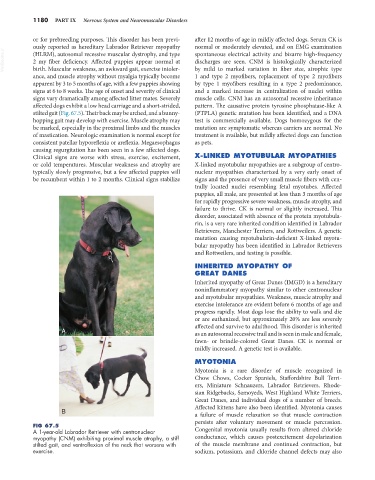Page 1208 - Small Animal Internal Medicine, 6th Edition
P. 1208
1180 PART IX Nervous System and Neuromuscular Disorders
or for prebreeding purposes. This disorder has been previ- after 12 months of age in mildly affected dogs. Serum CK is
ously reported as hereditary Labrador Retriever myopathy normal or moderately elevated, and on EMG examination
VetBooks.ir (HLRM), autosomal recessive muscular dystrophy, and type spontaneous electrical activity and bizarre high-frequency
discharges are seen. CNM is histologically characterized
2 my fiber deficiency. Affected puppies appear normal at
birth. Muscular weakness, an awkward gait, exercise intoler-
1 and type 2 myofibers, replacement of type 2 myofibers
ance, and muscle atrophy without myalgia typically become by mild to marked variation in fiber size, atrophic type
apparent by 3 to 5 months of age, with a few puppies showing by type 1 myofibers resulting in a type 2 predominance,
signs at 6 to 8 weeks. The age of onset and severity of clinical and a marked increase in centralization of nuclei within
signs vary dramatically among affected litter mates. Severely muscle cells. CNM has an autosomal recessive inheritance
affected dogs exhibit a low head carriage and a short-strided, pattern. The causative protein tyrosine phosphatase-like A
stilted gait (Fig. 67.5). Their back may be arched, and a bunny- (PTPLA) genetic mutation has been identified, and a DNA
hopping gait may develop with exercise. Muscle atrophy may test is commercially available. Dogs homozygous for the
be marked, especially in the proximal limbs and the muscles mutation are symptomatic whereas carriers are normal. No
of mastication. Neurologic examination is normal except for treatment is available, but mildly affected dogs can function
consistent patellar hyporeflexia or areflexia. Megaesophagus as pets.
causing regurgitation has been seen in a few affected dogs.
Clinical signs are worse with stress, exercise, excitement, X-LINKED MYOTUBULAR MYOPATHIES
or cold temperatures. Muscular weakness and atrophy are X-linked myotubular myopathies are a subgroup of centro-
typically slowly progressive, but a few affected puppies will nuclear myopathies characterized by a very early onset of
be recumbent within 1 to 2 months. Clinical signs stabilize signs and the presence of very small muscle fibers with cen-
trally located nuclei resembling fetal myotubes. Affected
puppies, all male, are presented at less than 3 months of age
for rapidly progressive severe weakness, muscle atrophy, and
failure to thrive. CK is normal or slightly increased. This
disorder, associated with absence of the protein myotubula-
rin, is a very rare inherited condition identified in Labrador
Retrievers, Manchester Terriers, and Rottweilers. A genetic
mutation causing myotubularin-deficient X-linked myotu-
bular myopathy has been identified in Labrador Retrievers
and Rottweilers, and testing is possible.
INHERITED MYOPATHY OF
GREAT DANES
Inherited myopathy of Great Danes (IMGD) is a hereditary
noninflammatory myopathy similar to other centronuclear
and myotubular myopathies. Weakness, muscle atrophy and
exercise intolerance are evident before 6 months of age and
progress rapidly. Most dogs lose the ability to walk and die
or are euthanized, but approximately 20% are less severely
affected and survive to adulthood. This disorder is inherited
A as an autosomal recessive trail and is seen in male and female,
fawn- or brindle-colored Great Danes. CK is normal or
mildly increased. A genetic test is available.
MYOTONIA
Myotonia is a rare disorder of muscle recognized in
Chow Chows, Cocker Spaniels, Staffordshire Bull Terri-
ers, Miniature Schnauzers, Labrador Retrievers, Rhode-
sian Ridgebacks, Samoyeds, West Highland White Terriers,
Great Danes, and individual dogs of a number of breeds.
Affected kittens have also been identified. Myotonia causes
B
a failure of muscle relaxation so that muscle contraction
persists after voluntary movement or muscle percussion.
FIG 67.5
A 1-year-old Labrador Retriever with centronuclear Congenital myotonia usually results from altered chloride
myopathy (CNM) exhibiting proximal muscle atrophy, a stiff conductance, which causes postexcitement depolarization
stilted gait, and ventroflexion of the neck that worsens with of the muscle membrane and continued contraction, but
exercise. sodium, potassium, and chloride channel defects may also

